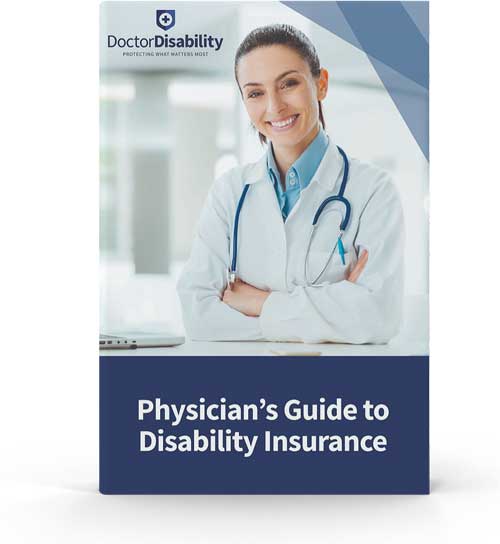Long-Term Care Insurance for
Physicians and Dentists
Protect what matters most.
Get a personalized side-by-side policy comparison of the
best long-term care insurance companies from an
independent insurance broker.
Protect what matters most.
Get a personalized side-by-side policy comparison of the
best long-term care insurance companies from an
independent insurance broker.






Compare policies from best
long-term care insurance companies.

Choose a policy and complete your application in 15 minutes or less.

Rest easy knowing that you and your
loved ones will be taken care of.
Having long-term care insurance can greatly reduce the physical, emotional, and financial burden on your family. It ensures your loved ones aren’t forced to become full-time caregivers or make tough financial decisions about your care. This insurance offers professional care options, allowing your family to focus on their relationship with you rather than caregiving duties.

High Lifetime Risk: About 70% of adults who reach age 65 will need some form of long-term care during their lives

Emotional and Physical Strain on Caregivers:Family caregivers often experience high levels of stress and health issues, with 23% reporting health problems due to caregiving responsibilities

Impact of Chronic Conditions: Chronic illnesses often lead to the need for long-term care. For example, stroke survivors frequently require extensive long-term support.

Financial Impact on Families: About 25% of adults who provide care to a family member experience financial hardship due to caregiving expenses
Over the last 20 years, we have helped thousands of physicians get life, disability and long-term care insurance. We work with all of the major insurance companies and and make it easy for you to choose the best plan for your needs.

Because life, disability and long-term care are our primary focus, we know how to design policies so that you only pay for what you really need. In addition, because of our large volume, we have access to discounts that will save you money.

Whether you are an anesthesiologist, hospitalist, or orthopedic surgeon we understand your unique challenges and will help you secure your income with the best life, disability and long-term care insurance available on the market.

We make life, disability and long-term care insurance easy to understand, easy to compare and easy to apply for.

We’ve helped thousands of medical professionals get the right life, disability and long-term care insurance to protect their financial futures. We work with all of the major insurance companies and are licensed in all 50 states.

Our experienced agents work exclusively with doctors; we understand your busy schedule and desire to have the highest quality benefits available.

We only recommend disability policies with an own-occupation definition of disability. This means YOUR occupation is protected!











Discover the essentials of a great disability insurance policy.
Long-Term Care insurance is a vital financial tool designed to provide security and peace of mind for you and your loved ones.
Long-term care insurance (LTCI) is a vital component of financial planning, designed to cover the costs of long-term care services that are not typically covered by regular health insurance or Medicare. These services include assistance with daily activities such as bathing, dressing, eating, and mobility, either at home, in assisted living facilities, or nursing homes.
Key Features of Long-Term Care Insurance:
Coverage Options: LTCI policies can vary widely in terms of what they cover. Some policies may only cover specific types of care, such as in-home care or nursing home care, while others provide more comprehensive coverage that includes adult day care and assisted living.
Eligibility: Most policies require a medical assessment to determine eligibility. The insurance company will review your health history and current health status to set premiums and coverage levels.
Premiums and Inflation Protection: Premiums for LTCI can be costly, but many policies offer inflation protection, ensuring that your benefits keep pace with rising care costs over time. This feature is crucial given the rapid increase in long-term care expenses.
Benefit Triggers: Benefits are typically triggered when the policyholder can no longer perform two out of six “activities of daily living” (ADLs) without assistance or suffers from severe cognitive impairment.
Duration of Benefits: Policies can specify the duration of coverage, ranging from a few years to a lifetime. Choosing the right duration is essential to balance cost and potential need.
Long-term care insurance can provide financial security and peace of mind, ensuring that you or your loved ones receive the necessary care without depleting savings or imposing a significant financial burden on family members.
Understanding key terms in long-term care insurance (LTCI) is essential for making informed decisions. Here are some important terms you should know:
Activities of Daily Living (ADLs): These are basic tasks necessary for everyday living, such as bathing, dressing, eating, toileting, transferring (moving from bed to chair), and continence. LTCI benefits typically activate when you can no longer perform a specified number of ADLs independently.
Benefit Period: This term refers to the length of time the insurance policy will pay for long-term care services. Benefit periods can range from a few years to a lifetime. The longer the benefit period, the higher the premium.
Elimination Period: Also known as the waiting period, this is the amount of time you must pay for care out of pocket before your LTCI policy begins to pay benefits. Common elimination periods are 30, 60, or 90 days.
Inflation Protection: This feature adjusts your benefits to keep pace with inflation and rising care costs over time. It can significantly increase the cost of premiums but ensures that your benefits remain adequate in the future.
Maximum Daily (or Monthly) Benefit: This is the maximum amount the policy will pay per day (or per month) for covered long-term care services. It’s important to choose a benefit amount that aligns with current care costs in your area.
Premium Waiver: Many LTCI policies include a provision that waives premium payments once you start receiving benefits, making it easier to manage costs during a time of increased financial need.
Guaranteed Renewable: This means that as long as you continue to pay your premiums, the insurer cannot cancel your policy, although they can raise premiums for a class of policyholders.
Nonforfeiture Benefit: If you cancel your policy or let it lapse after having it for a specified period, a nonforfeiture benefit ensures you receive some value back, either as reduced benefits or a return of a portion of premiums paid.
Respite Care: This is temporary care provided to give a primary caregiver a break. Some LTCI policies include coverage for respite care, recognizing the need for caregivers to rest and rejuvenate.
Cognitive Impairment: Conditions like Alzheimer’s disease or dementia that significantly impair cognitive function can trigger benefits under many LTCI policies, even if the individual can perform ADLs.
Familiarizing yourself with these terms can help you better understand your options and choose the right LTCI policy for your needs.
Choosing the right long-term care insurance company is a crucial decision that requires careful consideration. Here are key factors to help you make an informed choice:
Financial Stability
Ensure the company has strong financial ratings from independent agencies like A.M. Best, Moody’s, or Standard & Poor’s. A financially stable company is more likely to meet its long-term commitments and pay claims.
Coverage Options
Look for a company that offers comprehensive coverage options, including various levels of care such as in-home care, assisted living, and nursing home care. Flexibility in policy options allows you to tailor coverage to your specific needs.
Premium Costs and Inflation Protection
Compare premium costs across different companies. While lower premiums may be attractive, ensure the policy includes inflation protection. This feature adjusts your benefits to keep pace with rising care costs over time, which is essential for maintaining the policy’s value.
Benefit Triggers
Understand the benefit triggers, which determine when you can start receiving benefits. Most policies activate benefits when you can no longer perform two out of six Activities of Daily Living (ADLs) or have severe cognitive impairment. Ensure the company’s definitions and conditions align with your expectations.
Customer Service and Claims Process
Research the company’s reputation for customer service and the ease of its claims process. Look for reviews and ratings from current policyholders. A company with a streamlined claims process and responsive customer service can make a significant difference during stressful times.
Policy Flexibility
Check if the company allows for policy adjustments over time. Life circumstances can change, and having the ability to modify your coverage without excessive penalties is beneficial.
Partnership Programs
Some companies offer partnership programs with state Medicaid programs, which can protect your assets if you exhaust your policy benefits and need to rely on Medicaid.
Discounts and Health Considerations
Inquire about available discounts, such as those for couples or good health. Some companies offer lower premiums for healthier individuals or provide discounts if both spouses purchase policies.
By evaluating these factors, you can choose a long-term care insurance company that offers the best balance of cost, coverage, and customer service, ensuring peace of mind and financial security for the future.
Life insurance is a vital financial tool designed to provide security and peace of mind for you and your loved ones.
At its core, life insurance is a contract between you and an insurance company: you pay regular premiums, and in return, the insurer promises to pay a designated beneficiary a sum of money upon your death.
There are two main types of life insurance: term life and permanent life. Term life insurance covers you for a specific period, such as 10, 20, or 30 years, and is generally more affordable. If you pass away during the term, your beneficiaries receive the death benefit. This type of insurance is ideal for those looking to cover specific financial obligations, such as a mortgage or children’s education, within a certain timeframe.
Permanent life insurance, which includes whole life and universal life, provides coverage for your entire lifetime and often includes a savings component known as cash value. Whole life insurance offers fixed premiums and a guaranteed death benefit, while universal life insurance provides more flexibility with premium payments and death benefits.
Life insurance is crucial for anyone with dependents or significant financial obligations. It helps ensure that your loved ones can maintain their standard of living, cover daily expenses, pay off debts, and manage future costs like college tuition. By securing a life insurance policy, you provide a financial safety net that supports your family’s needs even after you’re gone.
Understanding the basics of life insurance empowers you to make informed decisions about protecting your family’s future.
Understanding key life insurance terms is essential to making informed decisions about your coverage. Here are some fundamental terms to know:
Policyholder: The person who owns the life insurance policy and is responsible for paying the premiums.
Insured: The person whose life is covered by the insurance policy. Often, the insured and the policyholder are the same person.
Beneficiary: The person or entity designated to receive the death benefit from the insurance policy upon the insured’s death.
Death Benefit: The amount of money the insurer pays to the beneficiary when the insured passes away. This is the primary purpose of a life insurance policy.
Premium: The regular payment made to the insurance company to keep the policy active. Premiums can be paid monthly, quarterly, or annually.
Term Life Insurance: A type of life insurance that provides coverage for a specific period (term), such as 10, 20, or 30 years. If the insured dies during the term, the death benefit is paid out.
Whole Life Insurance: A type of permanent life insurance that covers the insured for their entire lifetime and includes a savings component called cash value.
Cash Value: A feature of permanent life insurance policies that builds up a savings element over time. The policyholder can borrow against or withdraw this amount under certain conditions.
Underwriting: The process the insurance company uses to evaluate the risk of insuring the policyholder and determine the premium rate.
Riders: Additional benefits or options that can be added to a life insurance policy for extra coverage or flexibility, such as a waiver of premium rider or an accelerated death benefit rider.
Familiarizing yourself with these terms can help you navigate the life insurance landscape and select the best policy for your needs.
Choosing the right life insurance company is crucial for ensuring you get the best coverage for your needs. Here are some key factors to consider:
Financial Strength: Check the financial stability of the insurance company. Ratings from agencies like A.M. Best, Moody’s, and Standard & Poor’s can provide insights into an insurer’s financial health and ability to pay claims. Companies with high ratings are generally more reliable.
Customer Service: Good customer service is essential. Look for companies with positive reviews and high customer satisfaction ratings. Websites like J.D. Power and the Better Business Bureau (BBB) can offer insights into the company’s service quality.
Product Offerings: Ensure the company offers a range of life insurance products that meet your specific needs, whether it’s term life, whole life, or universal life insurance. Some companies specialize in certain types of policies, so choose one that aligns with your requirements.
Underwriting Process: Different companies have varying underwriting processes and criteria. If you have health issues or other risk factors, look for a company with a flexible underwriting process that might offer better rates or more lenient policies.
Premium Costs: Compare premium quotes from multiple companies to ensure you’re getting a competitive rate. Use online comparison tools and consult with insurance agents to find the best deal.
Riders and Customization: Consider whether the company offers additional riders and customization options to tailor the policy to your needs. Common riders include accelerated death benefit, waiver of premium, and accidental death benefit.
Claims Process: Investigate the company’s claims process. A company with a straightforward and efficient claims process can make a significant difference during difficult times.
By considering these factors and conducting thorough research, you can choose a life insurance company that provides the coverage and support you need for peace of mind and financial security for your loved ones.
Disability insurance is designed to replace a portion of your monthly income if you are unable to work due to an illness or injury.
Long-term disability insurance pays you a monthly benefit if you get sick or hurt and can’t work. It’s basically income replacement insurance. You can use the money from the insurance policy to cover your rent/mortgage, utility bills, food and other living expenses.
The coverage applies to disabilities that happen both on and off the job. Many policies even cover you if you are traveling to a foreign country when your disability occurs.
The greatest benefit of owning disability insurance is financial peace of mind; knowing that no matter what happens, you’ll have the needed resources to maintain you and your family’s standard of living.
Monthly benefit: This is the amount of money the insurance company will pay you each month you are disabled. The benefit is paid at the end of the month and is typically paid to you tax-free.
Maximum benefit period: When you become disabled, benefits are paid to you as long as you remain disabled, up to the maximum benefit period. Benefit period options are 2 years, 5 years, to age 65, to age 70 and to age 65 with lifetime extension. The longer your benefit period, the higher your premium.
Elimination period: The elimination period is the length of time you must wait after you become disabled before your monthly benefit will be paid. Options are 60, 90, 180 and 360 days. The most common benefit period is 90 days.
Definition of disability: The definition of disability determines when you are considered disabled. The best policies consider you disabled if you are unable to perform the duties of your current occupation. This is referred to as “own occupation”. The least desirable definition is a policy that considers you disabled only if you are unable to work in “any occupation”.
Guaranteed renewable and non-cancelable: This means that, as long as you pay your premiums when they are due, the insurance company cannot cancel your policy, change your policy provisions or increase your premium (up to age 65). The benefit to you is that once you qualify for the initial policy, your rates will never go up and the insurance company cannot change or terminate your contract.
Residual (partial) benefit rider: The residual benefit pays you a partial benefit if you have a partial disability. What this means is that if you get sick or injured and suffer a partial loss of income, you’d receive a benefit equal to the percentage of your lost income.
COLA rider: The cost of living adjustment, or COLA, increases your monthly disability payout during a period of disability to offset for inflation. This is important if you have a lengthy disability claim.
Guaranteed Insurability Rider: This rider provides a guaranteed option to buy additional disability insurance in the future without health requirements (no medical exam/questions). Financial underwriting is required, but an injury or illness would not prevent you from purchasing additional insurance. This option is especially important to professionals who expect a large increase in their future income – like medical residents/fellows.
Choosing the right life insurance company is crucial for ensuring you get the best coverage for your needs. Here are some key factors to consider:
Financial Strength: Check the financial stability of the insurance company. Ratings from agencies like A.M. Best, Moody’s, and Standard & Poor’s can provide insights into an insurer’s financial health and ability to pay claims. Companies with high ratings are generally more reliable.
Customer Service: Good customer service is essential. Look for companies with positive reviews and high customer satisfaction ratings. Websites like J.D. Power and the Better Business Bureau (BBB) can offer insights into the company’s service quality.
Product Offerings: Ensure the company offers a range of life insurance products that meet your specific needs, whether it’s term life, whole life, or universal life insurance. Some companies specialize in certain types of policies, so choose one that aligns with your requirements.
Underwriting Process: Different companies have varying underwriting processes and criteria. If you have health issues or other risk factors, look for a company with a flexible underwriting process that might offer better rates or more lenient policies.
Premium Costs: Compare premium quotes from multiple companies to ensure you’re getting a competitive rate. Use online comparison tools and consult with insurance agents to find the best deal.
Riders and Customization: Consider whether the company offers additional riders and customization options to tailor the policy to your needs. Common riders include accelerated death benefit, waiver of premium, and accidental death benefit.
Claims Process: Investigate the company’s claims process. A company with a straightforward and efficient claims process can make a significant difference during difficult times.
By considering these factors and conducting thorough research, you can choose a life insurance company that provides the coverage and support you need for peace of mind and financial security for your loved ones.
These companies currently offer an own-occupation definition of disability insurance for doctors along with a guaranteed renewable and non-cancelable contract:

